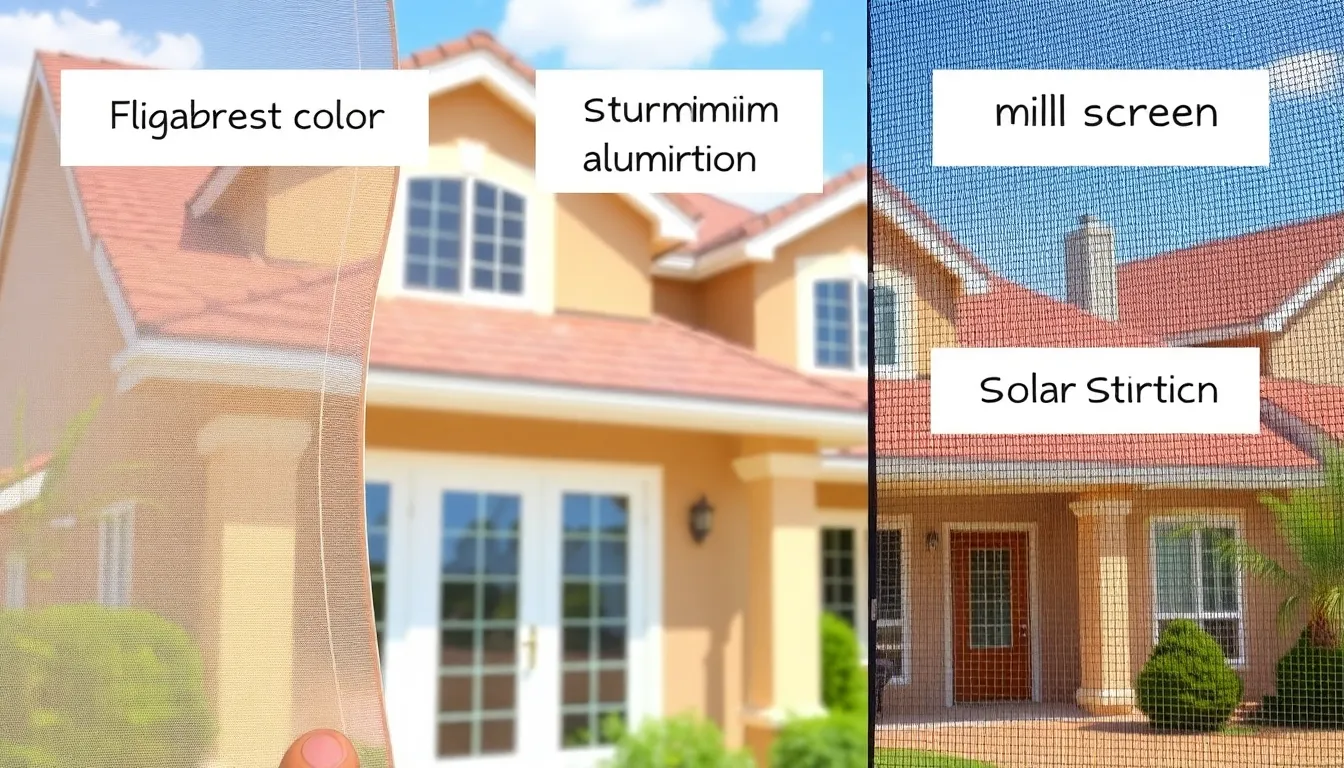A torn window screen can feel like an open invitation for bugs to throw a party in your home. Who needs a pest control service when you’ve got a gaping hole letting in the neighborhood’s finest flies and mosquitoes? But fear not! Window screen repair isn’t just a chore; it’s an opportunity to reclaim your space from uninvited guests while adding a touch of DIY flair to your life.
With a little know-how and a few handy tools, anyone can turn a frayed screen into a fortress against the great outdoors. Whether it’s a simple patch job or a complete screen replacement, mastering this skill can save money and keep your home cozy. So grab your toolkit and get ready to transform that sad, sagging screen into a barrier of brilliance—because who wouldn’t want to enjoy fresh air without the buzz?
Table of Contents
ToggleWhat Is Window Screen Repair?
Window screen repair involves fixing or replacing damaged screens to maintain their effectiveness in keeping pests out. Torn or worn screens compromise their ability to provide ventilation and protect against insects. Homeowners often rely on this repair as a cost-effective solution that enhances comfort.
Repair includes several methods. Minor tears can be fixed with screen patches, while complete replacements may be necessary for extensive damage. Tools such as screen spline, spline rollers, and utility knives aid in the replacement process. These tools simplify adjustments and ensure a secure fit.
Material choice matters in window screen repair. Fiberglass screens provide durability and visibility, while aluminum screens offer sturdiness but can be prone to bending. Understanding the differences helps in selecting the best option based on needs.
Repairing window screens contributes to energy efficiency. Screens allow fresh air circulation while blocking unwanted pests. Maintaining intact screens reduces reliance on air conditioning, leading to lower energy bills.
Assessing screen condition regularly ensures timely repairs. Signs of wear might include rust, tears, or loose frames. Checking screens helps maintain a barrier against mosquitoes and other insects during warmer months.
Neighborhood aesthetics can be positively impacted by well-maintained window screens. Repairing windswept or frayed screens complements home exteriors. It promotes a tidy appearance and reflects a homeowner’s commitment to upkeep.
Skill levels vary. For some, DIY repairs bring satisfaction; for others, hiring a professional might be preferable. Choosing the right option maximizes effectiveness while minimizing disruption, offering flexibility in home maintenance.
Common Types of Window Screens

Window screens come in various types, each suited for different needs. Understanding these options helps homeowners make informed decisions during repairs or replacements.
Fiberglass Screens
Fiberglass screens offer durability and flexibility. They resist rust and corrosion while allowing light and airflow. Available in various colors, these screens blend well with different home aesthetics. Commonly used for their cost-effectiveness, they also withstand fading. Homeowners appreciate their easy installation process, which typically requires minimal tools. Regular cleaning maintains their clarity, ensuring effectiveness against insects.
Aluminum Screens
Aluminum screens provide exceptional strength and long-lasting protection. They withstand harsh weather conditions, making them suitable for outdoor use. These screens come in a variety of finishes, including paint or mill finish. Aluminum screens resist damage from pets and heavy winds, appealing to families with active lifestyles. Their lightweight nature simplifies installation and repair, which many homeowners find convenient. Maintaining aluminum screens involves occasional cleaning to prevent corrosion.
Solar Screens
Solar screens serve a dual purpose by blocking harmful UV rays while providing insect protection. These specialized screens reduce indoor temperatures and glare, improving energy efficiency. Homeowners benefit from lower energy bills as solar screens reduce reliance on air conditioning. Available in multiple mesh densities, they cater to specific sunlight exposure needs. Easy to install, these screens often enhance indoor comfort. Regular inspections ensure maximum performance, especially during peak sunlight hours.
Reasons for Window Screen Damage
Window screens face damage from various sources. Identifying these causes helps in maintaining the effectiveness of screens and enhancing home comfort.
Wear and Tear
Daily use contributes to screen wear and tear. Over time, screens may develop frayed edges and small holes. Handling screens during cleaning can also create stress points. Routine checks help catch minor damage before it worsens. Homeowners should consider replacing screens every few years to ensure optimal performance.
Weather Effects
Severe weather conditions pose significant threats to window screens. Hail and heavy winds can cause physical damage, leading to tears or dislodged frames. Prolonged exposure to sunlight often results in fading materials and brittleness. Rain can introduce moisture, weakening the screen structure. Regular maintenance after extreme weather events ensures screens remain functional.
Pests and Wildlife
Insects and animals frequently inflict damage on window screens. Common pests like mosquitoes can chew through materials, creating entry points. Birds may attempt to perch or nest, causing tears or holes. Small animals might claw or push against screens while trying to reach shelter. Installing protective barriers enhances screen resilience against these intrusions.
Tools and Materials Needed for Repair
Repairing window screens requires specific tools and materials to ensure effective fixes. Collecting the right items streamlines the process.
Essential Tools
- Screwdriver: A flathead or Phillips screwdriver helps remove screens and reattach frames easily.
- Utility Knife: This tool scores and cuts screen materials with precision, essential for replacing torn sections.
- Screen Rolling Tool: This device firmly secures new screen material into the frame, preventing shifts during installation.
- Measuring Tape: Accurate measurements of frame dimensions prevent cutting errors and ensure a perfect fit.
- Pliers: Pliers assist in gripping and bending screen splines, allowing secure attachment of new screens.
Replacement Materials
- Screen Material: Fiberglass and aluminum are common choices; fiberglass offers affordability, while aluminum provides durability.
- Screen Spline: Essential for securing screens in place, splines come in various thicknesses to match specific frames.
- Adhesive Patches: These handy patches provide a quick fix for small tears without needing full replacement.
- Caulk: Caulk is useful for sealing gaps or holes around the window frame, reinforcing pest barriers.
- Corner Braces: Replacing damaged corners enhances screen stability and prolongs its lifespan.
Step-by-Step Guide to Window Screen Repair
This section outlines the essential steps for effectively repairing window screens.
Removing the Damaged Screen
Start by opening the window. Remove any screws or fasteners holding the screen in place. Gently pull the screen away from the frame to avoid bending it. If the screen is tightly fitted, use a flathead screwdriver to pry it loose without damaging the frame. Assess the screen for damage, noting whether it’s a small tear or complete replacement required. Gather all removed components to avoid losing them during reinstallation.
Preparing the Frame
Clean the frame to remove dust, dirt, or old adhesive. Use a damp cloth to wipe down the frame’s edges, ensuring a smooth surface for the new screen. Inspect the frame for any signs of wear, such as cracks or corrosion. If minor damage exists, repair it with caulk or replacement corner braces to provide additional support. Measure the frame accurately using a measuring tape, ensuring the new screen material will fit perfectly.
Installing the New Screen
Lay the new screen material over the frame, making sure it extends beyond the edges. Secure it in place with a screen spline, pressing it firmly into the grooves of the frame. Utilize a screen rolling tool for a tight fit, ensuring no gaps remain that could allow pests to enter. Cut off any excess screen material with a utility knife for a clean edge. Finally, check that the screen is taut and properly fastened, resulting in a durable, effective barrier against insects.
Repairing window screens is a practical and rewarding endeavor that enhances both home comfort and aesthetics. By addressing minor tears or opting for complete replacements, homeowners can effectively safeguard their living spaces from pests while enjoying fresh air. Regular maintenance and timely repairs not only prolong the life of screens but also contribute to energy efficiency.
For those who prefer a hands-on approach, the right tools and materials make the repair process manageable and satisfying. Whether choosing fiberglass, aluminum, or solar screens, understanding the unique benefits of each type can guide homeowners in making informed decisions. Ultimately, maintaining well-functioning window screens is key to creating a comfortable and inviting home environment.


